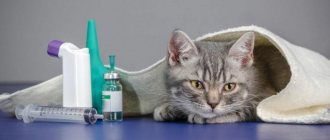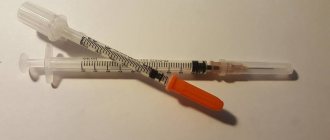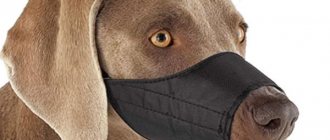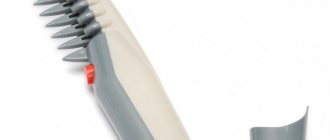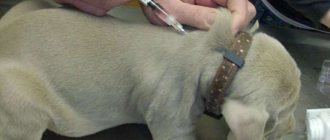Ekaterina Shulga
veterinary therapist
Veterinarians often prescribe subcutaneous injections to your pet, and the most common place for them is at the withers. Let's look in detail at how to give an injection to a cat at the withers at home. This skill will reduce the animal’s stress from going to the clinic and save your time.
- Choosing a syringe and needle
Where is the withers located in cats?
Let's figure out where to look for a cat's withers. The withers are the area where the back and neck connect. Most of it is located immediately above the shoulder blades; the skin in this place easily folds, creating a “pocket” where the injection can be made.
Why are injections given at the withers?
To quickly administer the drug and reduce pain, an injection is given to the cat at the withers. The area above the shoulder blades is insensitive, and when injected under the skin, the pet experiences virtually no uncomfortable sensations. The loose structure of the subcutaneous tissue, if necessary, allows the introduction of large volumes of solutions, thus conducting infusion therapy (droppers).
Other sites for hypodermic injections in cats
In addition to the withers, you can choose other places for subcutaneous injections. For example, the groin fold or the front of the thigh. The loose structure of the skin in these places makes the injection almost painless. Some drugs are even recommended to be placed specifically in the inguinal fold. It is recommended to place vaccines in the area of the inguinal fold, because this makes it easier to remove post-vaccination sarcoma if a complication occurs.
What is hormone therapy?
Hormones are biologically active substances produced by the body that control cell growth. Some organs in our body require sex hormones, such as estrogen and testosterone, to function and develop properly. In addition, there are thyroid hormones, as well as the insulin hormone, which have different functions. The development of some types of cancer can also be caused by the action of hormones. Therefore, in their treatment, drugs are used that disrupt, block and stop their work. This type of treatment is called "hormone therapy."
Preparing for the injection
To give an injection to a cat at the withers, you need to be fully armed. Select a syringe, prepare the drug and place for the procedure. If the pet is cowardly or aggressive, find a helper to secure the animal and secure it. To avoid additional stress for your cat, carry out the procedure in a quiet and calm atmosphere. Talk to her, pet her, calm her down. To distract your cat from manipulation, you can offer her treats.
Choosing a syringe and needle
The choice of syringe and needle depends on the size of the animal and the consistency of the drug. If the drug is oily, it is better to choose a needle with a thicker diameter. The thin needle will become clogged and the injection will not be possible. Also, if the drug is oily or in the form of a suspension, the procedure will cause more discomfort. The pet may jerk, causing the thin needle to bend. Therefore, to administer such drugs to adult cats, you can use a 5-10 ml syringe needle, and to kittens - 2-3 ml. If the drug is liquid, then we look at the size of the pet, the thickness of the skin and subcutaneous tissue. For kittens and very thin animals, a needle from an insulin syringe (1 ml) is enough; for more plump cats, a needle from a syringe 2-3 ml. That is, if you are giving an oil preparation to a kitten, you can take a large needle and an insulin syringe - this will make it more convenient to draw a small dose of the solution and inject it without any problems.
Preference is always given to short needles up to 3 cm - this way we reduce the risk of puncturing the skin through, introducing the drug into the muscle or trauma to the skin.
Each syringe has a scale. Depending on its volume, you can draw 1.0 ml, 2.0 ml, 3.0 ml, 5.0 ml, 10 or 20 ml of solution. Most often, 1-5 ml syringes are used for animals. The division features depend on the volume of the syringe, the volume is measured in cubes, one cube is equal to 1 ml:
- in a 1 ml syringe, large divisions are equal to 0.1 ml, small divisions are 0.01 ml;
- in a syringe with a volume of 2.0 ml, large divisions are 1.0 ml, small divisions are 0.1 ml;
- in a syringe with a volume of 5.0 ml, large ones are equal to 1.0 ml, and small ones are 0.2 ml, etc.
Preparing the medicine
Be sure to read the instructions for the drug. Requirements for its storage may differ in temperature - room or in the refrigerator, in access to light - some drugs should be stored in dark places or in dark containers.
Before the injection, it is necessary to warm the drug to body temperature, but not higher than 37 C. To do this, just hold the syringe with the drug in your hand for a few minutes. Most solutions cause discomfort in cats when administered cold.
Prepare the syringe and ampoule. Remove the syringe from the sterile packaging and check that the needle is firmly seated on the cannula. If the ampoule is glass, open it along the marked line by simply pressing it through a cotton pad. Some of them do not have such a mark, in this case, in the thinnest place, run the blade several times (it is usually included in the package of the drug) and press the same way. If it is a bottle and there is a rubber stopper on it, then you do not need to open it. We insert a needle into its center and draw up the drug. If there is protection on the plug - plastic or metal, it must be removed.
Tilt the ampoule slightly to one side, remove the cap from the needle and draw the required amount of the drug into the syringe.
After drawing the drug, lift the syringe with the needle up and release the air until the first drop of solution comes out of the needle. Put the cap back on. Check the dose taken, it should be equal to what the doctor prescribed for your cat. Warm the drug in your hand. If you cannot remove air from the syringe, the drug is foaming or thick, lightly tapping the syringe with your fingers and moving the piston up and down until all the bubbles are released. Also, first you can take the drug and warm it, and only after that - remove the air. So, most foam bubbles will burst on their own.
How to keep a pet?
If you have never given injections to your cat before, no matter the nature of your pet, it is worth being on the safe side.
There are special retainer bags. This bag is a kind of cocoon with locks or Velcro on different parts of the animal’s body. It allows you to isolate some part of the animal for the procedure - paw, tail, back. A soft clamp is fastened around the head, and it remains outside. However, as practice shows, such a bag is not ideal. Many cats become nervous and angry even at the stage of placing them in the bag. Also inside the bag, the cat's paws are free, and animals can stick them into the head hole or tear them with their claws.
In addition to paws with claws, teeth also pose a threat. To protect against them, use a muzzle. There are special muzzles for cats made of thick fabric; they completely cover the face and eyes, and are secured with Velcro behind the ears.
Hurry up, choose a box and find out what gift awaits you
Discount on pet insurance
Promo code copied to clipboard
To ensure your safety from cat teeth, a muzzle made from a plastic bottle is the best life hack. To make it, you need a bottle that is the right size for your pet. If you have a kitten, then you need a 0.5 liter bottle, if you have a large British cat, we take a wide 1.5–2.0 liter bottle. In the place where the neck is, depending on the size of your cat’s head, cut off a part of the bottle 10–15 cm long. Remove sharp edges by covering the cut with electrical tape or adhesive tape if the cut was uneven. Next, on its wide part, at an equal distance from each other, we make holes. We insert ties into them. Unscrew the cap, put it on your head and tie it tightly behind your ears.
Swaddling a cat is an excellent method of restraint that will help not only give an injection, but also give a pill if necessary. Take a large, thick towel/blanket/sheet/shirt and place it on top of the cat so that the head remains open. Pull the right edge of the towel to the left, tightly fixing the paw to the chest, and the left edge to the right. The ends of the towel should be on your back. Keep them taut. Fix the front paws, tuck the remaining free part of the towel from the tail side under the belly and firmly press the resulting cocoon with the cat to a horizontal surface. The denser the resulting cocoon, the less ability and desire the cat has to move. Or, if you have a helper, you can throw a towel over the cat. Press her to a horizontal surface with your chest, and hold her front paws with your hands. The second person administers the injection.
It is always important to calm your pet. If he is very scared, it is better to stop the procedure and give him time to calm down.
Rules
It may sound trivial, but your hands should be clean! If you had to give an injection in unsuitable conditions, use gloves or at least a new plastic bag. A few rules about syringes:
- Injections are made with freshly unpacked syringes.
- The needle must be sterile (it should not be touched with hands) and new. After the first injection of the drug, microscopic burrs appear on the needle, which interfere with repeated injection, that is, 1 injection = 1 new needle. If you need to give injections from one syringe, but several times, purchase syringes with spare needles (their caps are of different colors, so as not to get confused).
Never leave the drug in the ampoule for administration after some time. If you purchased an expensive medicine, draw it into several syringes at once and store it in the refrigerator. Some drugs cannot be stored for more than 10–12 hours after opening the ampoule; in this case, the option of storing in a syringe is also not relevant.
Important! Any drug, even drawn into a syringe, can be stored in the refrigerator for no more than 72 hours.
Injectable drugs, which are sold in powder form, are diluted with saline, novocaine or lidocaine . In this case, read the instructions carefully, since after dilution, the shelf life of the drug is very limited.
Important! If you do not know whether the drug can be stored in a syringe, be sure to consult your doctor.
Be careful, anyone, including you, can make a mistake. I may sell you the wrong drug by mistake, you yourself may confuse the ampoules, or one of your family members, trying to help, may mislead you. Before injecting the drug from the ampoule, read the name. If the expiration date or the name of the drug has been erased from the ampoule, do not use it.
If you are proceeding without your veterinarian's instructions, never mix multiple medications in one syringe . There is a high probability of oxidation of one of them or precipitation. In both cases, the injection will be useless.
The instructions for each drug contain a description of what the liquid or powder should look like. If the description does not match what you see, do not use the drug. There are a number of drugs that are stored only within certain temperature limits. Such medications should only be purchased from trusted pharmacies or from the veterinarian himself.
Even if the drug is prescribed by a doctor and you are given exact instructions, check:
- Is it possible to administer the drug to a pet? Some dog medications are toxic to cats.
- Is it possible to administer the drug subcutaneously? This information is in the instructions.
- What temperature should the drug be when administered? Some solutions need to be heated to 40° or administered cool.
- Are there any warnings in the instructions regarding the speed and method of administration; some drugs need to be administered very slowly or diluted.
- How long should you shake the bottle before withdrawing the drug into the syringe? Sometimes this needs to be done for several minutes or until the drug becomes completely homogeneous.
Modern manufacturers of injectable drugs package medications in ampoules with indicator circles or stripes. Logically, you need to press the ampoule away from you above the indicator and the neck will break off. In fact, you can “fight” with some ampoules for hours or even crush them. If the ampoule does not give in, a special stone is used to file the glass. Be careful, you can seriously cut yourself on the neck and broken part of the ampoule.
The necks of ampoules can be of different diameters. For convenience, a small ampoule (neck up to 2 mm) can be turned upside down and take the drug, don’t worry, it won’t spill out. The drug will flow through a neck of 3 mm or more, so it must be taken by placing the ampoule on a vertical surface.
Dial up the drug 0.5–1 division more than you need to inject. Then lift the syringe up with the needle and tap the syringe with your finger. Please note that you need to knock on the plastic, on the syringe itself, but not on the needle (it cannot be touched). Air bubbles will rise to the nozzle of the syringe. Tilt the syringe so that the bubbles are under the nozzle and press the plunger to expel the air.
Important! Air entering during an injection can only be fatal if we are talking about a large bubble that went through a dropper or a large volume of air injected directly into a vein.
With a subcutaneous injection, you need to get rid of the air in the syringe as much as possible, but one small bubble will not cause any problems.
General recommendations
Do not panic. The more afraid you are, the more unnecessary movements and sounds you will make that can frighten the cat. Your pet may sense something is wrong and begin to panic before you even begin to notice.
In order not to be distracted by searching, prepare everything you need in advance and put it within reach.
Carry out the procedures at rest. For example, when the cat has just woken up or started its normal daily activities. Do not perform the procedure when she is angry, playful, or completely in the mood for contact with you.
Calm your pet and talk to him throughout all manipulations.
If at the time of injection you see that the fur has become wet, then you have pierced the skin right through and the solution has begun to flow out. It is worth stopping the procedure.
INJECTION TECHNIQUE
Below is a general diagram, however, depending on the injection site, it will be supplemented with some nuances. You will read about these nuances below: in the part of the article where each injection technique is described (subcutaneous and intramuscular).
STEP #1. Prepare the tools: syringe, medicine, cotton wool (to open the bottle with the medicine), a file to open the medicine and alcohol (hydrogen peroxide). Everything should lie on a flat surface in one place.
STEP #2. Read the instructions for administering the drug. If it is written that it needs to be diluted in a solution or heated, etc., follow all the necessary steps. Or stick to what your veterinarian wrote. (If there are fundamental discrepancies in the veterinarian’s prescription and the instructions, it is better to call the veterinarian and check again whether you understood everything correctly.)
STEP #3. Disinfect your hands with alcohol, hydrogen peroxide, or another product.
STEP #4. Open the bottle using cotton wool, breaking off the top. Some bottles require filing with a special file: if this is the case, the file will be included. Before opening, make sure that the liquid is distributed evenly throughout the bottle. If there are bubbles or some liquid has gotten into the spout that you are about to break off, tap it with your fingers to move air to the top before opening it.
STEP #5. Draw the medicine into the syringe. You can draw by tilting the syringe and bottle almost horizontally or by turning the bottle upside down.
STEP #6. After you have drawn the liquid into the syringe, expel any trapped air. To do this, hold the syringe vertically with the needle pointing up and tap it with your fingernail. After this, when the air rises to the outlet, release it using the piston, holding the syringe with the needle up. Release air until liquid begins to come out of the needle. Perhaps after this, at the very exit of the syringe you will see a small, small bubble that does not come out: do not pay attention to it, it is not dangerous.
STEP #7. Place the cat on a flat, hard surface and have your partner steady it.
STEP #8. Now you can give the injection. If it is in the thigh, you don’t need to pinch the skin at the injection site. If the injection is at the withers, the skin must be grasped with your left hand (for left-handers - with your right). Take the syringe in your right hand (for left-handed people - in your left hand). Once you've aimed, gently but firmly insert the needle. The movement should be precise, accurate, fast, but not rude. The injection is not deep: 1 cm for an intramuscular injection and 0.5 cm for a subcutaneous injection.
STEP #9. Having inserted the needle, press evenly on the piston. Do not turn the needle inside the cat under any circumstances. The more medicine and the more painful it is, the slower it should be administered. However, the pet will not allow you to do this for too long. Therefore, a balance will have to be found. The main thing is not to inject so quickly that a lump of medicine forms under the skin: then it will be distributed throughout the body longer and cause more pain at the injection site. You can first practice on the pillow with a dry syringe, which you then throw away and take a new one for the cat.
Step #10. After injecting the drug completely, pull out the syringe along the same trajectory as you injected. The injection site does not require special treatment, because Cats have a protective layer on their skin that will prevent infection from penetrating inside. The main thing is that your hands and instruments are sterile.
We give the correct injection to the cat at the withers - step-by-step instructions
Let's consider point by point how to correctly inject a cat at the withers subcutaneously.
- Open the ampoule. Take the drug in the required dose and release the air. Warm it in your hand. Remove the cap from the needle immediately before delivering the injection.
- Grab the cat's skin between the shoulder blades with your fingers to form a small “pocket.” This will be the injection site for the drug. Massage the skin a little with your fingers, this will distract the cat's attention from the sensation of the injection.
- Take the syringe with your other hand, tilt the needle towards the cat's body at an angle of 40-45°, insert the needle about 1 cm. When you pierce the skin, you will feel the needle sink in and there is no resistance. This means that the puncture was performed correctly, and that is enough.
- Start injecting the solution. Don't do it too abruptly, but don't drag it out either. If the drug is liquid, administer it quickly, and a little slower if it is a suspension or oily solution. If you inject the solution too quickly, it may become painful, and if you inject it too slowly, your cat may become impatient and resist.
- Gently remove the needle and release the skin. There is no need to treat the injection site, as the fur will get in the way. If you have a Sphynx, or you have shaved the injection site, then treat the skin with chlorhexidine before and after the procedure.
- Release your pet. If he doesn't mind, you can pet him and put him to rest.
Nervous behavior
It happens that after an injection and similar medical procedures, the cat becomes nervous, does not touch itself, and hides from you at every opportunity. In veterinary practice, this phenomenon is called a psychological attack.
This causes changes in the functioning of the nervous system, resulting in fear of injections, stress when visiting a veterinary clinic or even when seeing a person in a medical uniform.
- In this situation, there is nothing you can do, you can only wait.
- After some time, your pet will return to its original state.
- You can try to cope with this with the help of treats, preferably harmless (fish treats, pieces of dehydrated meat, etc.)
Young cats can be entertained with games or walks to distract them from the psychological attack, unless treatment involves reducing activity.
Injection in the withers of a kitten
There are several features of how to give an injection to a kitten at the withers. Basically, they are related to its size and skin thickness. When injecting, insulin syringes are used and a needle is inserted 0.5–0.7 cm.
Also, if the volume of the solution is too large, then it is better to inject it into several places.
Be careful when restraining the animal. If the kitten is small, you can use its innate reflex. Your assistant takes the kitten by the scruff of the neck - as if its mother was carrying it, and it instinctively relaxes, tucks its hind legs and tail. This way you can deliver the injection safely and without resistance.
Lameness
Limping on the hind leg is common after injection. Most often, this happens after painful injections - antibiotics or thick, oily medications.
Veterinarians assure that there is no need to worry about lameness - most often, pets begin to run on the 2nd day.
But if your Murzik has been limping for 3-4 days, then you need to take action, since this is not a normal phenomenon. In this case, you need to show the cat to the doctor as soon as possible, and he will determine the cause of the lameness and prescribe the appropriate course of treatment.
Is it possible to give an injection incorrectly?
In this article, we discussed in detail how to correctly inject a cat in the withers subcutaneously. Everything is quite simple, and if you follow the instructions of the doctor and the drug, it is almost impossible to perform the procedure incorrectly.
The main thing is to secure the pet well and choose the right syringe and needle.
If you insert the syringe too deeply, the solution will get into the muscle. It can also leak because you pierced the skin all the way through. If the needle is not inserted deep enough, the injection will be intradermal, which is quite painful and can cause some complications.
Which syringe to use for injection
Injection is the administration of liquid medications using a syringe subcutaneously, intramuscularly, or intravenously. There are two more types of injections: intraosseous and intraperitoneal. But these manipulations can only be done by a specialist in a clinical setting. And intravenous injection is difficult to carry out independently. Owners can easily learn how to do subcutaneous and intramuscular injections themselves.
The syringe for injection should be selected in accordance with the prescribed drug and its quantity required for administration. For small doses, within 1 ml, you should choose an insulin syringe. It has a thin needle, and measuring the drug in a dose of less than 1 ml is much easier thanks to a more convenient scale. In all other cases, a syringe of 2 ml is used.
The insulin syringe has a thin needle and a convenient measuring scale
Complications after the injection
Always pay attention to your doctor's recommendations. Subcutaneously or at the withers - drugs are always administered only as prescribed by a doctor. If the drug according to the instructions is not to be administered subcutaneously, but only intramuscularly or intravenously, local reactions may occur - inflammation, pain, necrosis, abscesses. In this case, after a few hours, swelling and a hot lump will appear at the injection site, and the pet will feel unwell. Itching may appear, and pus may discharge from the injection site.
When blood vessels are damaged , bleeding
usually minor and goes away quickly on its own. You can apply ice to speed up this process.
After any injection, and subcutaneous injection is no exception, a hematoma
.
Seal
at the injection site - a common complication when administering drugs subcutaneously, especially if they are thick. It should not be hot, not painful, and should not bother the cat. Otherwise, it is better to contact a veterinarian.
Animals may have an individual reaction to the drug
. Unfortunately, it will not be possible to find out in advance about its availability. In case of a general reaction, the symptoms will be: itching, shortness of breath, redness of the mucous membranes, confusion. With local - extensive swelling in the injection area, usually painful and soft.
Cellulitis
– a rare, but still occurring complication after injection. This is a condition in which purulent inflammation of the soft tissue occurs at the injection site as a result of microorganisms. It can occur if basic rules of hygiene and antiseptics are not followed. It is necessary to use disposable syringes and needles, wash hands before procedures, use sterile preparations and, if there is no fur, treat with antiseptics.
Side effects
Sometimes complications may arise after the procedure, which frighten the owners. But not all of them are scary!
- If blood appears after the injection, stop it with peroxide. If bleeding continues for more than 20 minutes, call your doctor.
- The appearance of lumps or abscesses is an indication for urgent surgery.
- Lameness for 2-3 days is normal. But if the cat drags its paw, this may indicate damage to the sciatic nerve. Show it to your doctor immediately.
- A high temperature is an indication to consult a veterinarian to rule out the possibility of infection during the injection.
Are you afraid to give injections to your cat?
It’s natural to worry about your pet when administering an injection yourself. But, as we see, everything is quite simple. A subcutaneous injection cannot cause critical harm to your pet.
To overcome your fear, you can ask your doctor to show you how to perform the procedure correctly at your appointment and practice on plush toys.
Invite a support group; starting something new is always not so scary together.
Remind yourself that this is for the benefit of your pet. If not you, then who?
To visually understand how to perform this procedure, we suggest watching a video on how to inject a cat at the withers.
Heat
A slight increase in the animal’s body temperature after injection is considered an adequate reaction of the body.
- But if the high temperature persists for more than 3 days, then you need to immediately go to the veterinary clinic.
- Typically, this complication is associated with an allergy to a drug or the development of an inflammatory process.
We hope that this material was useful to you, and now you can give your cat an injection yourself. Good luck!
How to give an injection
The cat's withers are covered with rougher and thicker skin, unlike the rest of the body. This happened in the process of evolution, because in fights, cats throw themselves on each other’s backs and hold the enemy with their teeth. The mother cat carries her kittens by the withers for the same reason – it doesn’t hurt. The more painful the drug, the more strongly we recommend injecting it into this area. If there are scratches or other skin irritations on the withers, you can inject the drug into a fold of skin, moving lower along the spine.
When giving your pet an injection for the first time, it is better to enlist the support of another person. Even the calmest pets can panic and behave inappropriately. Before the procedure, play with your patient, stroke him, hold him in your arms. Be sure to voice your intentions and let your cat sniff the syringe. Most animals are confident that their owners will not hurt you on purpose, and if you behave steadfastly, the pet will not panic.
Just in case, have a large towel ready to cover and completely wrap your cat. It is more convenient to give the injection when the cat is lying on its stomach, and your assistant holds it by the front paws and calms it down. At the same time, you need to be behind the pet, so that in case of a jerk back, your body serves as a barrier. Naturally, the ward needs to be held tightly, but not so tightly as to frighten him in advance.
Before the injection, hold the syringe in your hand for a while to warm the drug, especially if it was previously in the refrigerator. There is no need to treat the skin and fur at the injection site, the main thing is that the needle is sterile, that is, it should not be touched or kept open unless necessary.
Using your entire free palm or several fingers (depending on the size of the cat), grab the fold of skin and pull it up to a level that is comfortable for your pet. The syringe should lie comfortably in your hand, the needle should be directed towards the spine at an angle of (approximately) 45°.
If you have already given intramuscular injections, you should understand that the needle will not go in so easily, it may even bend a little. Don't make sudden movements, but don't hesitate either. Smoothly and confidently insert the needle until you feel it fall through. If you press too hard, you risk piercing the fold through.
It is recommended to inject the drug slowly and remove the needle as smoothly as it was injected. Pulling the needle sharply can add additional discomfort to your cat, especially if the animal is dehydrated. After removing the needle, the injection site should be massaged and rubbed to increase blood circulation and speed up absorption.
Advice: if the cat strongly resists, the injection should be given in an unusual environment, for example, by turning on loud music or taking the pet to the landing. In the veterinary office, most animals calmly tolerate even painful injections.
Injection or shot: when and why?
Let's start with the fact that an injection and an injection are the same thing. This involves introducing the drug into the animal’s body by piercing the skin and certain tissues. Almost every cat owner has taken their pet to this procedure at least once and therefore is familiar with it firsthand. This could be regular vaccinations or supporting the caudate’s immunity after injury.
A skill such as injecting a cat at home will always come in handy. This will help save time and money, and in emergency situations even save the life of the animal.
Learning how to give an injection correctly is not difficult, but it is very important to know a few rules, which we will talk about later.
